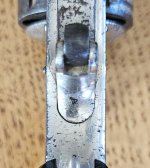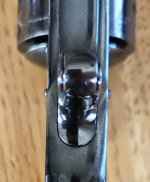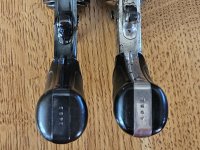You are using an out of date browser. It may not display this or other websites correctly.
You should upgrade or use an alternative browser.
You should upgrade or use an alternative browser.
Mexican Model Trigger Widths
- Thread starter Boulder350
- Start date
Register to hide this ad
dltvette
US Veteran
According to Robert J. Neal in his article, The Mexican - An S&W Mystery, he states: Early guns used a trigger width which was .197" wide and a guard of proper design to match it. As the width of the hammer was .225", the rear portion of the trigger did not use the full width of the notch surfaces of the hammer. This could cause a trench to wear on the hammer notches and result in erratic sear operation. Later guns used triggers the same width as the hammer to eliminate that possibility.
Dave
Dave
Boulder350
Member
Thanks Dave. I found the article Robert J. Neal you referenced. It provides a bunch of info I did not know.
My narrow trigger version is in pretty rough shape on the outside. I can only assume it pretty rough on the inside too. When pulling the hammer back it catches on what feels like a half cock notch and holds the hammer back. I can pull the trigger and the hammer falls the short distance to fire. It has the rebounding hammer but i can push it forward without pulling the hammer back when the hammer is resting all the way down. Either someone messed with the hammer or its has the condition Robert J. Neal described as erratic sear operation.
I tried removing the side plate but the smaller retaining screw is stuck. What is the solution everyone suggests soaking the gun in? 50% acetone and 50% automatic transmission fluid?
My narrow trigger version is in pretty rough shape on the outside. I can only assume it pretty rough on the inside too. When pulling the hammer back it catches on what feels like a half cock notch and holds the hammer back. I can pull the trigger and the hammer falls the short distance to fire. It has the rebounding hammer but i can push it forward without pulling the hammer back when the hammer is resting all the way down. Either someone messed with the hammer or its has the condition Robert J. Neal described as erratic sear operation.
I tried removing the side plate but the smaller retaining screw is stuck. What is the solution everyone suggests soaking the gun in? 50% acetone and 50% automatic transmission fluid?
mmaher94087
Member
Mark, I use the above formula if I'm soaking the entire revolver. For a single stuck screw then I use any of several penetrating products like Kroil, PB Blaster or Liquid Wrench. I spot-apply it to both ends of the screw and wait for it to work. A heat gun helps. The last upper side plate screw that I removed took six days of soaking, heat gun and torquing the screw but it came loose.
Boulder350
Member
Thanks Mike. Will give that a try
mmaher94087
Member
Mark, as you know, a properly fitted screwdriver blade is required. My six-day ordeal finally gave with heat and a wrench for leverage on the screwdriver that finally moved that blasted screw.
mmaher94087
Member
Mark, in your #3 post you mentioned the short fall of the hammer. Often that is the results of the wear on the rebound stop on the hammer. This stop was the first notch on the hammer and was designed to stop the forward movement of the hammer if dropped in such a way as to discharge a chambered round.
If the trigger catches another notch after the hammer rebounds, then there is a possibility the hammer has been messed with.
If the trigger catches another notch after the hammer rebounds, then there is a possibility the hammer has been messed with.
bcowern
Member
Be careful.
The side plate screws are not robust and liable to breakage if too much torque is applied trying to remove them.
Tapping on the end of a properly fitted screwdriver can help break them free, after the heat and soak.
Regards
bcowern
The side plate screws are not robust and liable to breakage if too much torque is applied trying to remove them.
Tapping on the end of a properly fitted screwdriver can help break them free, after the heat and soak.
Regards
bcowern
Last edited:
The early number I have is 3393 and was shipped to M.W. Robinson Dec 26, 1891 as a sample. It has a lany ring and is serial numbered on the left grip frame. Also has a spur trigger (.3445 ) and the flat sided hammer of (.266) and a trigger measurement of .196.
The other one that measures the same is 24254 brought back from Turkey.
# 3486, 8889, 9691 (brought back from Mexico) all have the smaller set up.
The other one that measures the same is 24254 brought back from Turkey.
# 3486, 8889, 9691 (brought back from Mexico) all have the smaller set up.
Boulder350
Member
Interesting Terry, thanks for sharing. Here is the info on the guns pictured in my first post.
Serial number 4931 has a hammer width of .255 and a trigger width of .195
Serial number 1463 has a hammer width of .255 and a trigger width of .255.
I sent in for a letter on both these revolvers to see where and when they shipped.
Serial number 4931 has a hammer width of .255 and a trigger width of .195
Serial number 1463 has a hammer width of .255 and a trigger width of .255.
I sent in for a letter on both these revolvers to see where and when they shipped.
Similar threads
- Replies
- 11
- Views
- 332
- Replies
- 2
- Views
- 468
- Replies
- 7
- Views
- 327
Latest posts
-
-
-
-
-
-
-
-
-
-
-
-
-
-
I got one of the revolvers I never wanted to receive. (Pic added)
- Latest: Thaddeus Beauregard



